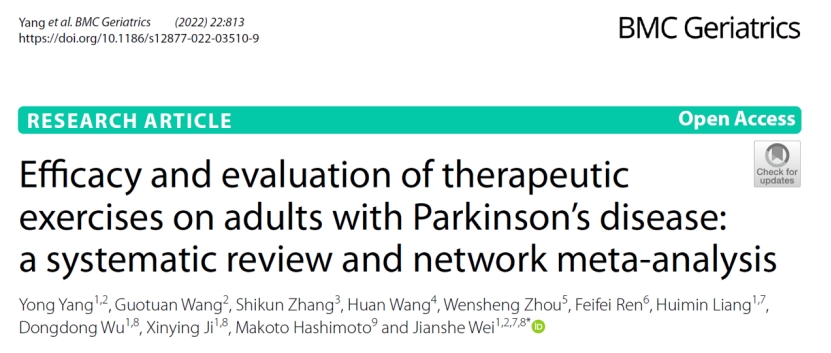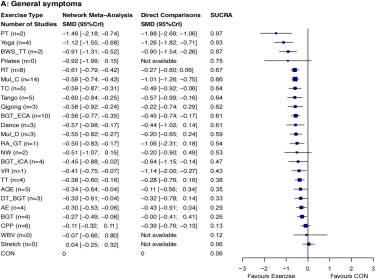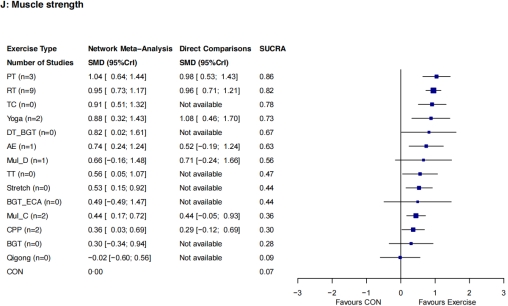On October 21, 2022, a research article titled with "Efficacy and evaluation of therapeutic exercises on adults with Parkinson’s disease: a systematic review and network meta-analysis" was published in the top international medical journal BMC Geriatrics (Top, IF = 4.070) by the Institute of Brain Science, School of Life Sciences, Henan University. The paper revealed that the comprehensive evaluation and efficacy on the improvement of the motor and non-motor symptoms in Parkinson's disease (PD) by the different exercise and physical activity. “It illuminates the new target and method in diagnosis and adjuvant medical therapy in Parkinson’s disease”, Professor Jianshe Wei introduced.

Neurological disorders are the main cause of disability. Parkinson's disease, the second most common neurodegenerative disease, is a serious threat to human health, and its prevalence is 1-2% in people over 60 years old. The number of PD cases worldwide is expected to increase from 6.2 million in 2015 to 12.9 million by 2040. The PD therapy mainly includes drugs, deep brain stimulation and rehabilitation therapy, among which non-invasive and non-pharmacological therapy of PD has attracted much more attention. Exercise and physical activity may relieve the PD syndrome, but it is still debatable upon the physical activity type, as well as exercise prescription and rehabilitation strategies.
The systematic review and network meta-analysis (NMA) in this study combined 11 effectiveness outcomes from 250 randomized controlled trials (RCTs) with 13011 participants on 24 exercise types and control groups, with motor symptoms (UPDRS III) as the primary outcome. This study aims to compare the effects of the different exercises on the treatment of motor symptoms, non-motor symptoms, muscle strength, and fall prevention in patients with PD.
The study results showed that 19 (79%) of 24 exercise types significantly relieved the motor symptoms of participants, and that power training (PT), Yoga, body weight support treadmill training (BWS_TT), resistance training (RT), and Multicomponent Exercise Program (Mul_C) are more effective than many other exercise types in this aspect. BWS_TT showed the best effect in improving the balance, gait velocity, and walking distance of participants, and Robotic Assisted Gait Training (RA_GT) had the most benefits in relieving their freezing of gait. For non-motor symptoms, Dance showed the best benefits for depression. Only Yoga significantly relieved the anxiety symptom, and only RT significantly enhanced the sleep quality and cognitive abilities of participants. For muscle strength, PT showed the best effects. In the concern of falling, five types of exercise (BGT_ECA, BGT, RT, VR, Mul_C) were more effective than CON, but their SMD values were small. The meta-regression results indicated that exercise period and its frequency could dramatically affect the effect of exercises on the improvement of motor symptoms, with ≥ 24 weeks and 5 times/ week being more effective.

Figure 1 Assessing the effects of different exercise types on the general clinical symptoms of Parkinson's disease

Figure 2 Assessing the efficacy of different exercise types on the muscle strength of Parkinson's disease
Dr. Yong Yang, from School of Physical Education and Sport of Henan University is the first author, and Professor Jianshe Wei is the corresponding author. Henan University is the first affiliation unit to complete the paper. Researchers from Jiangsu Police Institute, the Second Affiliated Hospital of Air Force Medical University, Nanjing Xiao-Zhuang University, Beijing Language and Culture University, and Tokyo Metropolitan Institute of Medical Science jointly participated in the research. The research was funded by the National Natural Science Foundation of China, the Natural Science Foundation of Henan Province, and the Bio-Med Interdisciplinary Innovative Program of Henan University.
Article link:
https://bmcgeriatr.biomedcentral.com/articles/10.1186/s12877-022-03510-9
https://papers.ssrn.com/sol3/papers.cfm?abstract_id=4002393

 News /
Content
News /
Content


